1795 – Settlers arrive in St. Charles County
Frontiersman Daniel Boone and members of his family were among the first Americans to settle in St. Charles County in 1795. They were followed by hunters and trappers.
Read more1800 – Thomas Gilmore Arrives
Thomas Gilmore arrives in the area. A gunsmith, he settles in the area that will later become known as Gilmore. Mr. Gilmore was one of a company to march against the British at Rock Island and was killed by Indians.
Read more1812 – White’s Fort Dog Prairie Built
The fort was located southwest of Wentzville.
Read more1813 – E. A. Pearce Arrives
E. A. Pearce, farmer and stock raiser, settles near Wentzville.
Read more1813 – Company of Rangers Organized
St. Charles County’s first Company of Rangers organized by Captain James Calloway.
Read more1820-1830 – Early Settlers Arrive
Between 1820 and 1830 early settlers arrived in the Wentzville area. Many of these families came from the Rockingham, North Carolina area and were related by blood or marriage.
Read more1828 – William M. Allen’s Family Arrives
Joseph S. Allen, a distinguished Methodist minister and father of William M. Allen (founder of Wentzville) settle near Wentzville.
Read more1834 – Giessen Emigration Society Arrives
In 1834, the largest organized German emigration group arrived in Missouri. They came from all walks of life and from all size towns and villages. They were Catholic, Protestant and Jewish. This group would be some of the first German emigrants in the area.
Read more1836 – Flint Hill Established
Excerpts of the History of Flint Hill
(from “Flint Hill: 150 Years, 1836 – 1986″ by Barb Eisenbath Mittelbuscher”
Flint Hill is one of the oldest communities in St. Charles County. Originally, it was located on Mexico Road and the Salt River Road, two of the early main roads in the county.
Flint Hill was officially founded in 1836 by Captain Taliferro P. Grantham. Captain Grantham purchased 160 acres of land from Benjamin Pierce and then donated 10 acres for the town of Flint Hill. Settlers from Flinthill, Virginia, were moving west in 1833 and came upon this area. It so reminded them of their home in Virginia, that they settled the area and named it Flint Hill after the town they had left. They also realized the area could produce the crops they grew in Virginia – tobacco.
Flint Hill was originally settled by people of the Methodist faith. Between 1848 and 1855, Catholic families moved into the area.
Some of the leading tobacco producers had their start in Flint Hill. George S. Myers of Liggett Myers Tobacco Company was born on May 4, 1832, in Flint Hill. His parents and several sisters are buried in a private cemetery on Mexico Road. Between 1860 and 1872, Myers was in partnership with several different people, but in 1873 he went into partnership with John Liggett and Liggett & Myers Tobacco Company was formed.
Paul Brown entered the tobacco business in the Flint Hill area in 1868. In 1881 the Brown Tobacco Company was incorporated and Paul Brown was elected president.
By 1857 Flint Hill was a prosperous and growing town. They had a nice hotel, three dry goods stores, a saloon, a tailor shop, a tobacco factory, a farm implements factory, a blacksmith shop, and an attorney. There were also numerous medical doctors in the Flint Hill area. The stage coach, carrying both passengers and mail, passed through Flint Hill and terminated at Troy. In 1857, the first train pulled into Wentzville it was the beginning of the decline of business in Flint Hill. Many factories and businesses slowly moved to Wentzville to be near the railroad station.
Read more
1837 – First Methodist Sermon
In 1836 or 1837 one of the first Methodist sermons in the county was preached by Bishop Marvin between Flint Hill and Wentzville.
Read more1837 – Josephville Established
The community now known as Josephville began in the early l800s as a mail stop and mercantile known as Schmuckers Store in Allen’s Prairie. The land was ceded through a Federal Grant under President Martin Van Buren by Joseph Allen in about 1837. Allen settled on a farm and, along with a group of other French and English settlers from the Virginias, made improvements to the land, erected buildings, then sold the land and moved on. The majority of permanent settlers were German immigrants who were able to purchase the land for $1.25 per acre.
It might be assumed that the town was named after Joseph Allen, however in the article “How Missouri Counties, Towns and Streams Were Named” by David Wolfe Eaton written for the Missouri Historical Review between 1916 and 1918 it is claimed that the town was named after its first postmaster Joseph Wilmer. Wikipedia states: “A post office called Josephville opened in 1875, and remained in operation until 1910. The community was named for its first postmaster, Joseph Wilmes.”
Read more1838 – More Early Settlers Arrive
James B. May, liquor dealer, settles in Wentzville. Warren W. Walker, farmer and teacher, settles near Wentzville. The Walker home was located between Wilmer and Hepperman Road, a little south of the railroad tracks.
Read more1839 – New Melle Settled
Settled by immigrants from Melle, Germany in 1839. New Melle lies between Wentzville, Defiance, Foristell, Augusta, and O’Fallon and is about 37 miles west of St. Louis. The first settlers found their way up the Mississippi and Missouri Rivers to St. Charles and traveled west along the Booneslick Trail, then south to the highest point, a site that reminded them of their homeland and was appropriately named “New Melle”.
The immigrants organized the St. Paul Lutheran Church in 1844 and quickly formed a town. The town was platted and a post office established in 1850. Before 1900, there were four general stores, a mill, small hotel, two wagon makers, three blacksmith shops, a public school, two parochial schools, a creamery, a furniture shop, shoe cobbler, jeweler, brick kiln, and a large park. All was thriving until the Great Depression in the 1930s, followed by World War II in the 1940s
Read more1840 – Dr. John A. Talley
Dr. John A. Talley arrives from North Carolina. Stays at the home of C.F. Woodson, located a few miles south of Wentzville. The Woodson plantation was approximately located in the area of the Hopewell Baptist Church on HWY N.
Read more1841 – Slickers Organized
The Slickers were organized to rid the county of thieves and counterfeiters. The name of the organization came about because they would tie the culprit to a tree and “slick” or whip him with hickory sticks. He was then given notice to leave the country within a stated time. The first Slicker organization in Missouri started in Benton County. At times, false reports were made and people were unjustly accused. This led to the organization of the anti-Slicker companies, and in some parts of the State actual war raged between the opposing factions, and many persons were killed, wounded, or maltreated. A complete account of the Slickers can be found here: http://www.hearthstonelegacy.com/the-slicker-wars-missouri.htm
Read more1841 – Dr. James D. Harris Born
Dr. James D. Harris, physician and surgeon, was born in or near Wentzville. A blinding snow was falling on January 8th, 1886 in Wentzville. The St. Louis train from Omaha, which did not stop in Wentzville, was running 3 hours late. Dr. James D. Harris was a respected doctor and druggist in Wentzville. Even though he was only in his 40’s, he was also very hard of hearing, perhaps even deaf. When he decided to cross the railroad tracks, he thought the train had been through town. Blinded by the snow and hard of hearing, he stepped directly in front of the train. His body was thrown on the platform of the train station, were he breathed his last. When…
Read more1842 – Joel E. Carr Settles in Wentzville
Joel E. Carr, a tobacco dealer, settles in Wentzville.
Read more1845 – Company of Anti-Slickers Organized
A company of anti-slickers organized near Flint Hill to protect local citizens from Lincoln County slickers. James Shelton was elected captain.
Read more1847 – Hickory Grove Christian Church Organized
Hickory Grove Christian Church was located south of Foristell. By 1889 the church had ceased operation and many early members had transferred their membership to the Foristell Christian Church.
Read more1849 – Dr. Russel Bell Lewis Begins Practice in Flint Hill
Born in Kentucky, Dr. Lewis had moved to Flint Hill with his family when he was 6 years old. As property values declined in Flint Hill, Dr. Russell Lewis purchased most of the land and rented out the dwellings. Dr. Lewis also bought property in Wentzville. One property in Wentzville was the building that would become know as the Chauncy Building. The R.B. Lewis Addition and Lewis Street in Wentzville are named after the doctor and were developed on ground that Dr. Lewis owned and had been part of his estate at the time of his death in 1903.
Read more1850 – Tobacco From 1850-1880
From 1850 through the 1880’s Wentzville and the surrounding area was known for raising tobacco. George S. Myers (a partner of Liggett and Myers), Paul Brown, Joel Carr, Robert and Caleb Dula (Chairman and first President of Liggett and Myers respectively), John and Jim Drummond all worked or owned tobacco factories in the area. Many became millionaires and they or their families are buried in the area.
Read more1850 – New Melle Platted
In 1850 the town of New Melle was platted and a Post Office was opened. The area had been settled in 1839 by German immigrants from Melle Germany.
Read more1855 – Wentzville Founded
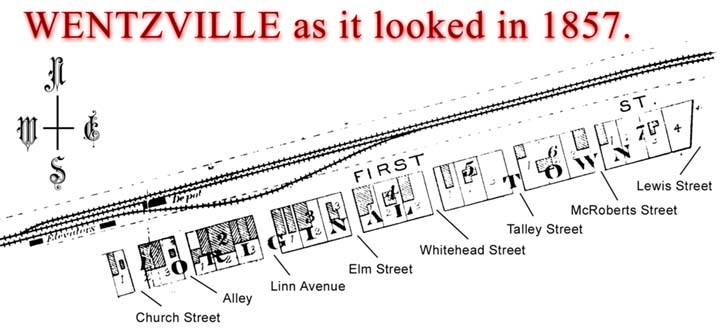
Wentzville was founded in 1855. A railroad was pushing across Missouri to the west to carry settlers and to furnish services for those few who were already established in the new area. This movement prompted William M. Allen, a great land owner and slaveholder in Western St. Charles County, to give a tract of land along the railroad right-of-way…
Read more1856 – Land Purchased for Millville aka Snow Hill
According to articles printed in the “Cracker Barrell News” by J.W. Schiermeier, a land transaction is completed for a new town named “Millville” (or Mehlville) on land owned by Joel Adison and Francis M. Davis and a Post office is established under the name “Snowhill”. The first Postmaster was J.P.Simpson. Railroad tracks were laid down for the Wabash, St.Louis & Pacific Railroad. Landowner in the area are chiefly settlers from Virginia.
Read more1856 – Railroad Construction
The railroad construction pushed through Wentzville during the year 1856. The construction and building of the line was under the supervision of Mr. Erasmus Livingston Wentz of New York State.
Read more1857 – Millville Platted
Millville was officially platted on both sides of the railroad tracks with 14 lots on the south side, and 20 lots on the north side.
Read more1859 – Joseph Carter Goodrich DDS Settles In Wentzville
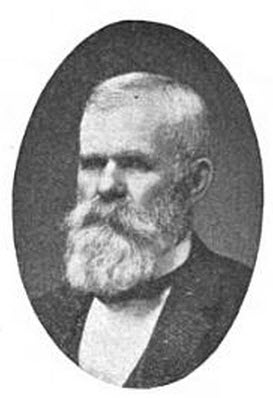
Joseph Carter Goodrich DDS Dr. Goodrich was a dentist in Wentzville for over 40 years, born in Amherst County Virginia April 14, 1825, to Gideon (1785-1835) and Elizabeth Carter (1793-1859) Goodrich. His father was a farmer and Dr. Goodrich received his early education in the small schools in Callaway and Monroe Counties. In 1847, Dr. Goodrich enlisted in the United States Army. He fought in the Mexican War, and in July…
Read more1866 – First Wentzville Newspaper Established
William S. Bryan established the St. Charles News in Wentzville. He would later move the paper to St. Charles. Wentzville would be without a local newspaper until 1891 when Joseph W. Dickey established The Wentzville Union.
Read more1866 – Masonic Order Receives Charter
The Masonic Order of Wentzville receive its original charter.
Read more1866 – Methodist Church Organized
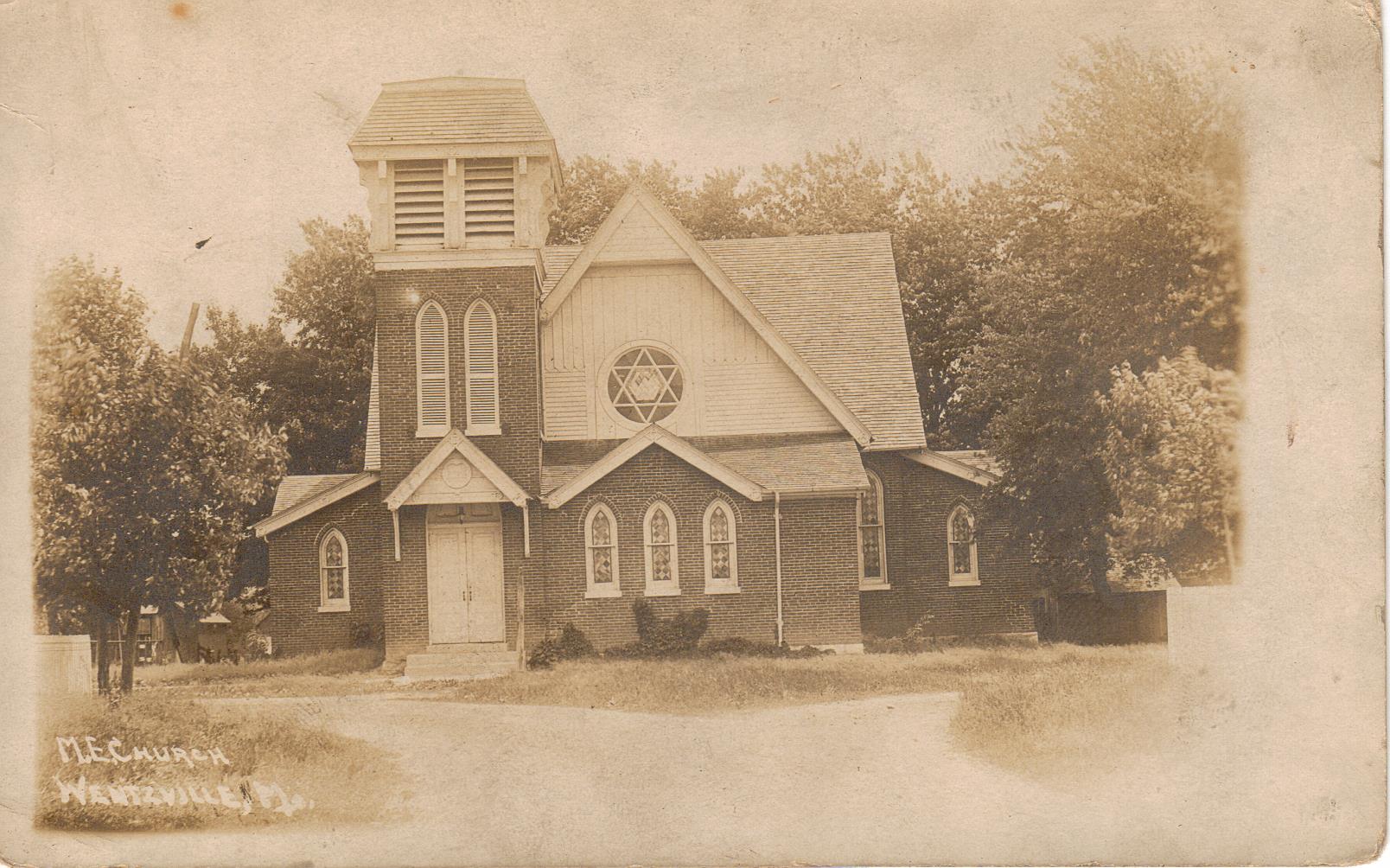
In February 1866 the first church in what was then Wentzville was founded (due to annexation it is not believed to still be the first). At that time the church was called the Methodist Episcopal Church South. The church building built between 1866-1867 was located on what is today East Pitman Ave (formerly 2nd Street) between Elm and Whitehead Streets. During this time Methodist Churches in the area relied circuit riders to preach at the various churches, and their services often…
Read more1872 – Wentzville Incorporated
Wentzville was incorporated as a fourth class city in March, 1872. Eighty-three citizens sign the charter which officially names the town of Wentzville. All proceedings between 1872 and 1890 were lost.
The government is composed of an elected Mayor and six aldermen, with an appointed city administrator.
Read more1875 – Millville Name Changed to Foristell
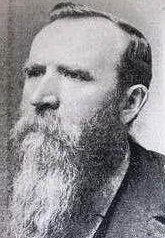
The name Millville changed to Foristell, honoring Pierre Foristell. The Snowhill Post office now beomes Foristell Post office.
Read more1882 – Fire South East Side Wentzville
In 1882 a fire was discovered in the lumber yard of Henry Michel, which was located in the vicinity of Second Street ( now Pitman) and Elm Street. It was reported that the fire was fought by a 200 man bucket brigade. While fighting the fire, it was discovered that the three-story frame building to the east on the corner of Second Street (Pitman) and Whitehead was also on fire. That building housed the Methodist Church, the school and on the third floor the Masonic Lodge. The fire in the building started on the 3rd floor and arson was suspected. All was loss. Today (2019) the block is home to Friendship Brewery.
Read more1882 – St. Partick’s Catholic Church
St. Patrick Parish began as a mission parish of Montgomery City. Reverend J. J. Head attended to the mission. On September 15, 1882, Bishop Patrick J. Ryan dedicated this mission as St. Patrick Parish. For the dedication, Christian Brothers College 40 piece band played on the band stand near the Dierker Brothers Hotel. The hotel stood on the northwest corner of West Allen and North Linn. The families of Reinecke and Mispagel mortgaged their farms to raise money to get the parish started. The land (three and half acres) was bought from Colonel Joseph and Mrs. Ruth Savage for $200.00. This property is the present site of the parish buildings on Church Street.
Read more
1883 – St. Theodores Established in Flint Hill
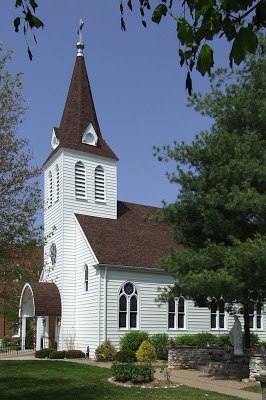
The first Catholic Church in Flint Hill was built in 1883. Named St. Theodore after Rev. Theodore Krainhardt, the building was about 20 by 40 feet. It would later be converted into a two room school house for the parish when the new church, presently standing, was built in 1900. St. Theodore School building was brought to the present state with the building of the first section in 1913 and then the addition in 2000.
Read more1891 – Wentzville Union Established
Several sources say that the Wentzville Union was founded by W.S. Dickey. But if you read early editions of the Warrenton Banner and the Wentzville Union it would appear that the Wentzville Union was founded by Joseph W. Dickey. According to early newspaper reports, in 1901 Joseph Dickey sold the paper to Mary Morley of Wellsville, but he remained editor. In 1903…
Read more1874 – Immanuel Lutheran Church Organized
The German Independent Evangelical Lutheran Church of Wentzville was organized November 7th. The Rev. Fredreich W.G. Matuschka of New Melle served the congregation. The original red brick church was erected at a cost of $1500. The building located on Pitman Ave, still stands and as is used as a private home. The church is later renamed Immanuel Lutheran
Read more1898 – Fire Downtown Wentzville
In December of 1898 Wentzville had a fire that destroyed an entire block of the business district. The Warrenton Banner reported that: “The fire was discovered in the wagon shop of F. Schierbaum spread to an immense warehouse, a large boarding house occupied by Mrs. Boyd” this house also included the offices of the Wentzville Union and Dr. Goodrich, and the Banner article referred to this as the Goodrich Building. The Banner article continues: “On the west side of the wagon shop was a large building occupied as a residence by Mr. Schierbaum. W.E. Penn, a banker and DR. J.T. Evans had offices in this last building”. The Banner reported that all buildings were of frame construction and “burned like kindling wood”. Loses were estimated at $10,000 and that the owners only carried about $4000 in insurance. The Banner expected all buildings to be rebuilt. Later that month…
Read more1902 – Leader Newspaper Launched
In December 1902 the Warrenton Banner announced that Robert Howard had launched a new newspaper in Wentzville called the Leader. It appears that the paper lasted less than a year.
Read more1980 – General Motors
General Motors begins construction on a auto assembly plant. The plant provided 6,000 jobs when it went into full operation.
Read more2017 – New City Hall opened
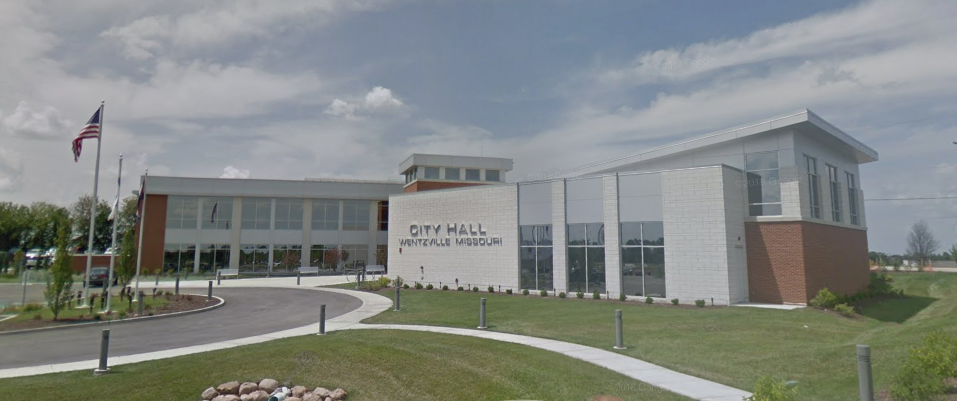
A new city hall building at 1001 Schroeder Creek Boulevard opened on November 8, 2017. The new location brought all the city employees from five different buildings into one site. The overall project budget was $15 million, including work to the parking lot, building and furniture. The city paid for the new location without debt.
Read more